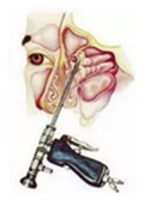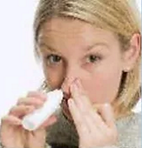Rhinology-Diseases of the Nose and Paranasal Sinuses
Long Standing blocked nose? It Could Be Nasal Polyps, Severe Septal Deviation, Enlarged Turbinates or Tumor Growth
Do you have a frequent blocked or congested nose, decreased sense of smell, snoring and dry throat that do not improve with over-the-counter medications? If so, have your nose checked for the presence of nasal polyps that may be causing these symptoms. Nasal polyps are fleshy swellings that develop in the lining of the nasal cavity and paranasal sinuses which are air-filled spaces within bones of the skull and face.
Data show that nasal polyps are about four times as common in males than females and its age of predilection is 40 years and above, although it can develop in children as well. Individuals with nasal allergies, rhinosinusitis, bronchial asthma, frequent sinus infections are more likely to develop nasal polyps than the rest of the population.
Nasal polyps can cause the following symptoms: persistent nasal congestion (stuffy/blocked or clogged nose), post nasal dripping, throat clearing ("pesteng ehem"), decreased or poor sense of smell and taste, hyponasal voice ("ngo-ngo"), occasional halitosis (bad breath), snoring, dryness of throat, pressure around the face and at times headaches.




Your doctor will be able to make a diagnosis after getting your detailed medical history and physical examination. The best way to visualize the nasal cavity and check for the presence of nasal polyps and its location is through the use of a special instrument called a nasal endoscope usually done in the doctor's clinic with minimal discomfort.
Nasal polyps are usually benign or non-cancerous growths and are most of the time found in both nostrils. If the mass is one sided, the doctor may suggest biopsy to rule out the possibility of a more aggressive tumor growth.


The cause of nasal polyps is unknown but inflammation plays a major role and therefore it make sense to treat this problem with anti-inflammatory agents and most experts would recommend the use of intranasal corticosteroid spray as an initial treatment strategy. Some doctors will combine intranasal steroid spray with short course high dose oral steroids to try shrink the nasal polyps faster. It is also very important to control coexisting allergies of patients for optimum effect of therapy.


There are ways that we can improve our surroundings to lessen the irritations that can lead to nasal inflammation, which is perceived to be a major factor for nasal polyps to form. You can use air filters and humidifiers in your home or workplace. Regular hand-washing reduces the risk of infections, as well as avoidance of allergens, chemicals and airborne pollutants. Proper control of nasal allergies and asthma has been known to decrease the burden of nasal polyps. It is now a good health practice but would require education of the public to have a regular nasal saline irrigation (douche or lavage or wash) for older children, adolescence and adults not nasal saline sprays, drops, nebulizers nor aerosolize-pressured nasal sprays that are available in the market.

Nasal saline sprays (small volume - low positive pressure) are good for babies and children (1-3 yrs old) because they cannot clear their mucus themselves. But these would need immediate suctioning (nasal aspirators) of the nasal cavity. Nasal washing or douche or lavage, irrigation (high volume-high positive pressure) using saline solutions not only improve mucus flow but also decreases, dilutes and at times help remove nasal irritants. It is claimed that nasal saline irrigation reduces mucosal dryness, eliminates secretions that may harbor bacteria, and facilitates the clearance of thick mucus and crusts in patients with rhinosinusitis.


In the presence of nasal polyps (Grade 2 or 3: large polyps blocking nasal cavity airway and sinus drainage) as seen through nasal endoscopy, nasal saline sprays and irrigations are not advisable but instead the use of corticosteroids nasal spray as per E.N.T specialists or other medical care giver's prescription. This is to reduce edema and swelling of nasal cavity mucosa or might reduce the size of the polyps in preparation for Endoscopic Sinus Surgery which is a must for obstructed sinuses for proper delivery of drugs as shown in the CT-Scan of the paranasal sinuses

The CT Scan study of the nasal and paranasal structure (FESS protocol) may occasionally be requested by your doctor to map out the polyp and the disease. This is done to guide the health provider regarding the next step of the treatment planning when appropriate medical treatment fails and possible Endoscopic Sinus Surgery for removal is being considered.


Endoscopic sinus surgery is performed most commonly in these situations. This procedure doesn't require an external or facial incision for removal of the nasal polyps and the technique attempts to preserve as much normal structures as possible for faster recovery of the patient.

Although surgery is associated with significant improvement in the most patients, unfortunately, nasal polyps tend to recur if the underlying irritation, allergy or infection is not adequately controlled. In order to avoid possible recurrences of polyps and infections good postoperative care is important.



The most recent trend as reported in the literatures is the use of corticosteroid in nebules (respules/nasules/pump sprays) to be incorporated with nasal saline irrigators (lavage or douche) not corticosteroids nasal spray, nebulizer or mist because they are small volume, low positive pressure devices that will not enter into the targeted areas such as the ostiomeatal complex and the paranasal sinuses of the nose.

Corticosteroid nasal saline irrigation (squeeze bottles e.g. NeilMed Sinus Rinse or other electro-mechanical devices such as the SanVic pulsatile delivery devices) is use to deliver drugs and cleanse the important targeted areas of the nose such as the middle meatus and enlarged opening of the sinuses (ostiomeatal windows of more than 4 to 5 mm) done through Endoscopic Sinus Surgery. Nasal Saline irrigation mixed with drugs (corticosteroids) can be properly delivered to all disease nasal and sinus mucosa because it is high volume and high positive pressure delivery system.




As compared to corticosteroids nasal sprays and mist form or nasal saline sprays these devices reaches only the atrium or anterior 1/3 segment of the nose. Nasal saline irrigation mixed with drugs (corticosteroids, antihistamines) not only improve mucus flow (ciliary beat flow) but also decreases, dilutes and at times help remove nasal irritants, pollens, allergens and Biofilms and to control or delay recurrences of nasal polyps, and allergy with better and longer symptomatic relief and a significant treatment effect.

In cases of highly suspected infection, one can do culture directed treatment in the presence of bacteria and fungal elements and more recently biofilm and Staphylococcus aureus (Super Antigen) in the mucopurulent discharge of the sinuses in CRS patients has reinvigorated the belief that antimicrobial therapies may have a role in the treatment of this condition.

Other causes of prolonged nasal obstruction are severe nasal septal deviation due to trauma and congenital deformities of the nose and chronic enlarged nasal turbinates which does not resolved or shrink in size with medical drugs and nasal sprays. This would need surgical correction during Endoscopic Sinus Surgery for better control of nasal obstruction and proper delivery of nasal drugs and saline irrigation post-operatively.
For refractory or recalcitrant and recurrent chronic rhinosinusitis with nasa polyps, a more thorough evaluation of the nasal and paranasal sinuses is being done. A good CT-Scan of Paranasal Sinuses (FESS protocol) in 256 or higher slices are requested. Diagnostic work-ups for Allergic Fungal Rhinosinusitis and possible Biofilm and Super Antigen infection are to be considered. This time for maxillary sinuses an Endoscopic Modified MaxillaryAntrostomy (EMMA), polypectomy and Draf III or Full-house (Fronto-sphenoethmoidectomy) are being done. A good post-operative care should be observed with an adjunctive treatment of corticosteroids nasal irrigation for three months and then continuous nasal saline irrigation. Antibiotics can be given under culture-directed treatment. Spray antihistamine with corticosteroids combination are being considered now. Other novel drug delivery system such as Sinus-Eluting Stents e.g. SINUVA and LYR-210 (Mometasone furoate) and some Target therapies Monocional Antibodies are still under clinical study.
